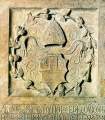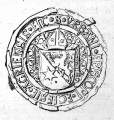the Drágfis, Peter Beriszló, the Ernuszt family, Orban Nagylúcsei
| |
|
An aristocratic family from Rumania, who became Hungarian by the 15th century. Their ancestor was a Moldavian voivode's son, Drág (†1400), who settled in Hungary and received offices and estates after he had become a Catholic. Bartholomew (1447-1501), who worked at the court, then became a Transylvanian voivode, was the head of the richest family of the region beyond the river Tisza, who was obliged to set up a bandery from 1498. His son, John (†1526) also worked for the court, later becoming a country judge. He was one of the leading personalities of the Jagello age, and one of the most intelligent aristocrats of the period. His letters and documents (for example, his two testaments) written by his own hand were one of the earliest pieces of the Hungarian language. His son, Caspar (†1544 or 1549), played an important role in spreading the reformation in the region beyond the Tisza. After they had become Catholic they remained the advowees of their Greek catholic monastery at Körtvélyes.
GYR
Peter (Péter) Beriszló (1475-1520)
A Hungarian prelate of south Slav patrician origin. He was a diplomat and military commander. He got to the royal chancellery as a canon from Peter Váradi's court. As a reward for his diplomatic endeavours he became the prepost of Fehérvár (1507-1511), then bishop of Veszprém (1511-1520). In 1513 the king appointed him Croatian-Dalmatian and Slavonian ban, and royal treasurer. Besides these offices he became captain of Zengg, the prior of Vrána and ban of Jajca. He had his most famous victory over the Turks in the battle of Dubica (1513). After Ulaslo II's death he gave up his position as treasurer, and he stayed in the ban districts which were exposed to Turkish attacks. If it was necessary he spent his bishopric revenues on military purposes. He was about to be appointed cardinal, when he fell in the battle of Korenica while pursuing the defeated Turks.
GYR
the Ernuszt family
A Hungarian aristocratic family of Jewish origin. John (†1476), a tradesman in Buda, became king Matthias's treasurer. He was the organiser of the reform of the treasury. Matthias gave him big estates and appointed him to be the ban of Slavonia. Through his marriages he joined the Hungarian aristocracy. His fortune was inherited by his two sons. One of them, Sigismund (1450-1504) was bishop of Pécs from 1473 until his death. In 1494-1496 he was governor, too, and the Ernuszt book of accounts has survived from that time. It was made because of a charge for disloyal handling, and it contains the tax summary of the whole country, with the exception of 14 counties. In his testament he left a significant sum for the fortification of the fortresses of Nándorfehérvár and Szabács. His other son, John (the younger), (after †1519), was a baron, and in 1498 he was mentioned among barons who had a bandery. The family died out in 1540. His fortune was inherited by his brother-in-law's family, the Keglevich, then by Nicholas Zrinyi.
GYR
Orban (Orbán) Nagylúcsei (†1491)
He originated from a serf family. From 1470 he worked as an Ernuszt familiare in the treasurer's office. Soon he became vice-treasurer, then treasurer (1479-1490), but he also made his career in the church. First he was canon, prepost, then bishop of Győr (1481-1486) and Eger (1486-1491), and the governor of the bishopric of Vienna (1487-1490). When king Matthias died he became the vice palatine and he supported Ulaslo II. He had earlier been known as Dóczy, although this was a mistake.
GYR

